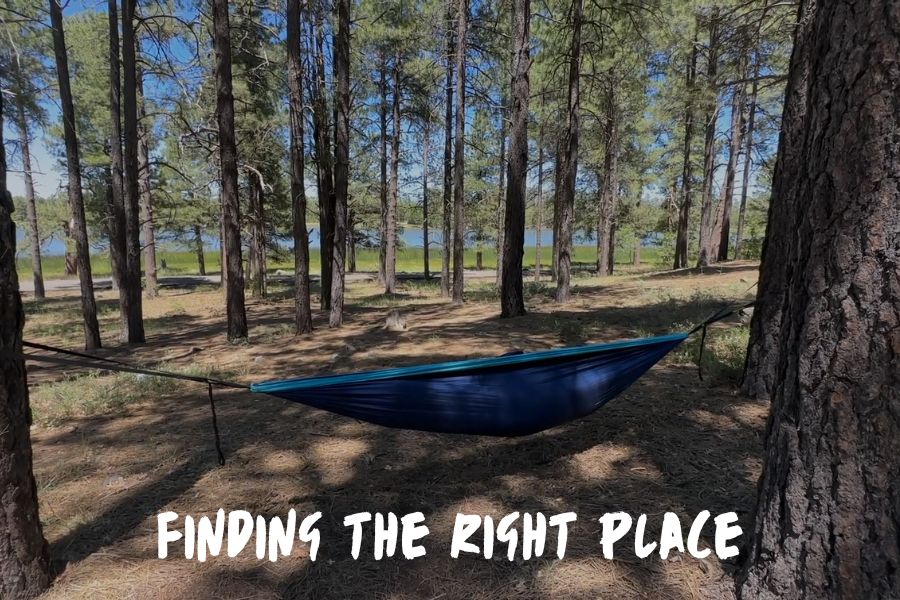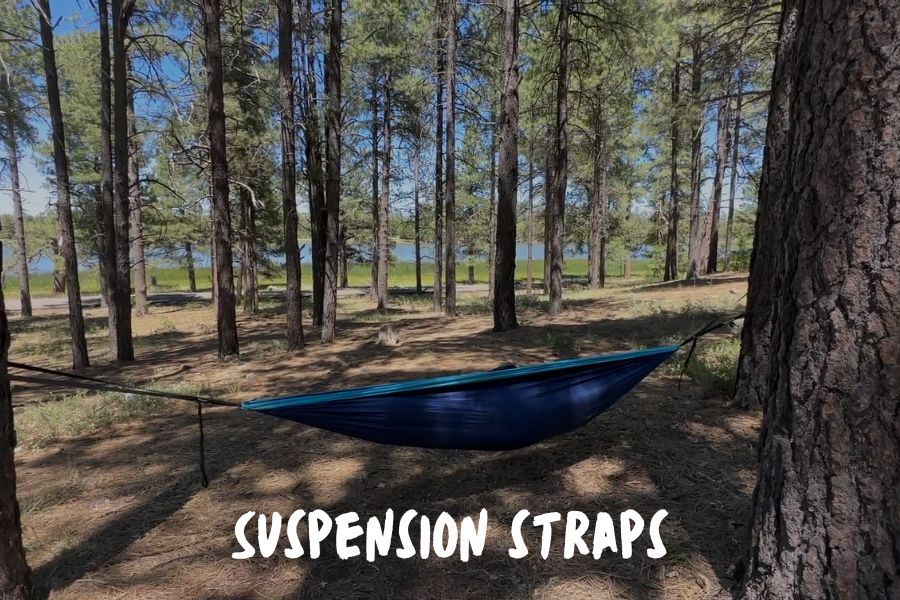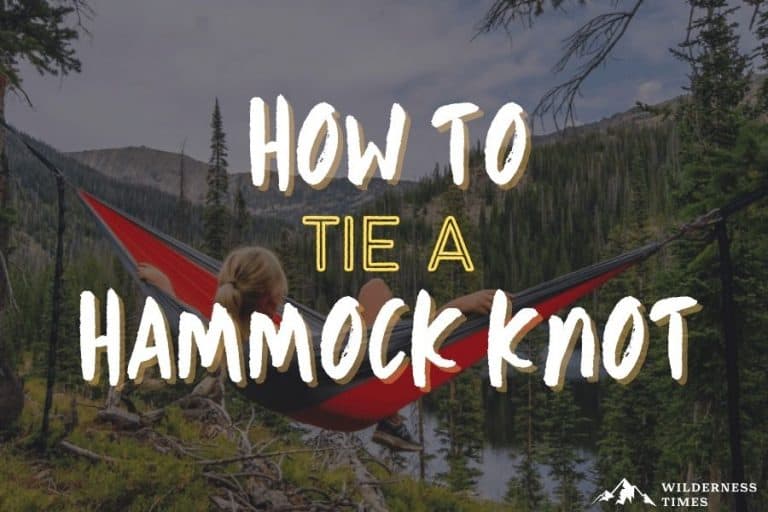Not sure how to tie a hammock? Well, you’ve come to the right place. I’m about to take you through everything you need to know about all the different hammock suspension systems out there. In this guide, you’ll learn:
- 5 different knots for tying your hammock
- 3 different ways to hang a hammock
- How to find the right place to hang your hammock
- A few safety tips to keep in mind
Ready? Let’s get this show on the road.
5 Different Knots For Tying Your Hammock
If you’re using webbing, the hammock knot is the way to go. If you’ve decided to use rope, the next thing you’re going to have to decide on is which knot you’re going to use to tie your hammock. You’ve got a few different options:
Hammock knot
This is one that works well for both webbing and rope. If you want a single knot that you can use for both suspension methods, this would be the one to go for.
It’s an impressively strong knot, so you’ll never have to worry about it coming undone. It’s also quick to tie and untie, which is a plus.
Bowline knot
Also known as the king of knots, the bowline knot is the preferred option for a lot of hammock campers.
This knot can hold a heavy load without any issues, and you won’t have any problems untying it when it’s time to pack up. With a little bit of practice, it can also be tied with one hand, which is pretty neat.
One thing I should mention about this one is that it loosens when it’s not under tension. So, it’s a good idea to tighten it before getting into your hammock to make sure it doesn’t come undone.
Falconer’s knot
This one’s a little bit more difficult, but it’s a secure, strong knot. It was originally used to tie falcons to perches, so it definitely won’t come undone on you.
Taut line hitch
Ok, so technically this isn’t a knot, it’s a hitch, but it serves the same purpose and works just as well, so the taut line hitch definitely definitely earned its place on this list.
What’s great about this one is that it’s got adjustable tension, so you can tighten it without having to untie the knot and start over.
It’s also really quick and easy to tie and untie, which makes it super convenient for backpacking and camping trips.
Shoelace knot
Here’s a basic knot you already know. If you end up blanking and forgetting all the fancy knots you learned, you can always resort to the classic shoelace knot. Just loop, swoop and pull! You’ll want to tie a double knot to make sure it doesn’t come undone, though.
Recommended article: Eno Hammock Review
Finding the Right Place

Unless you’ve got a stand hammock, you’re going to have to search for a place where you can tie your hammock. This isn’t always going to be easy. Finding two trees that are neither too close together nor too far apart is more difficult than you’d think sometimes.
The distance you want between your trees is going to depend on the size of your hammock, and how high up off the ground you want it to be. A good rule of thumb I like to use is the +5 rule. Take the length of your hammock and add another 5 ft, and that’s around about the distance you’re looking for. You should end up with your ropes at a 30° angle, which is ideal for most people.
You’ll need to find trees that are both healthy and thick enough to support your weight. If a tree isn’t thick enough to climb, it isn’t thick enough to hang a hammock off.
Between two trees is a typical place to hang a hammock, but if you’re using suspension straps you can also tie your hammock to other things, such as rocks.
Recommended article: Best Sleeping Pad For Hammock Camping
3 Different Ways to Hang a Hammock
The first thing to consider is which suspension method you want to go for. A hammock can be suspended in several different ways. These are the main ways you can go about it:
Rope
If you’re keeping it old school, you’ll probably be hanging your hammock using rope and a carabiner or hammock hooks. This is the original way it was done, and a lot of people have stuck with it even after new methods became available.
The best thing about rope is that it’s super versatile. It’s also lightweight and convenient to pack, which is a huge plus if you’re backpacking.
There are, however, a couple of issues with using hammock rope. The first is that you have to learn how to tie a knot, but that’s easy enough.
The second issue is more serious. Tying a hammock to a tree using rope damages the trunk’s outer bark. This might not seem like serious damage, but it can actually be detrimental to the tree. Damage to the outer bark interferes with the tree’s ability to feed itself, causing it to wither.
Don’t worry though, you can still use rope and avoid damaging the trees by following Leave No Trace principles. They suggest collecting a handful of sticks an arm’s length long, and positioning them about a hand’s width apart between the tree trunk and your rope.
Suspension straps

Also known as webbing or a hammock strap system, suspension straps are a brilliant alternative to rope. They’ve got all the same benefits as rope but unlike rope, they don’t do any damage to the tree trunks you tie them to.
Another great thing about webbing is that it’s super easy to use. You don’t have to learn how to tie any knots, so you’ll have your hammock hung up and ready to go in no time at all, even if you’ve never done it before.
If you haven’t already decided, I’d strongly recommend going for suspension straps. This is by far the best way to tie a hammock of all the available options.
Stand

If you want to bypass trees altogether, consider a stand hammock. What’s great about these is that you can put them up anywhere, even if there aren’t any trees around. This means you can even use it on the beach, which is a nice little perk.
Once upon a time, stand hammocks were only used as backyard furniture. Their large and heavy frame made it impossible to take them on camping trips, let alone hiking.
Today, that’s no longer the case. There are many portable and lightweight stand hammocks available on the market, so you can now take them with you everywhere you go.
Recommended article: The 5 Best Hammock Tarps For Staying Dry While Sleeping
Safety Tips
Since you’re suspended in mid air when you’re laying in a hammock, there are a few precautions you should take to avoid serious injury in the event of a mishap.
- You should always be prepared for the possibility of your hammock coming loose unexpectedly. For this reason, make sure you don’t hang it too high up off the ground. That way, if you do come crashing down, you won’t have too hard of a fall.
- Make a habit of checking your knots before you get into your hammock. Yes, every time. It’s better to be safe than sorry. Certain kinds of knots, such as the bowline knot, can come loose after a while if there isn’t any tension on them.
- The ropes or straps you’re using must be designed to support heavy weight. You may think it’s only your body weight you have to consider, but the weight on the ropes is actually around 2.5 times the amount you weigh.
- You’ll also want to make sure you’ve got good quality carabiners, with a rating of at least 500 lbs.
- Once you’re in the hammock, if either of the trees you’re hanging off bend, you should definitely move to another spot. You might think a tree trunk is stable enough, but if it’s bent, that’s a clear indication that it isn’t.
- Make sure there aren’t any dead tree branches hanging above your head, as they could come falling down straight onto your head at any moment.
Recommended article: Tent Vs Hammock Camping
Summary
Now you know how to tie a hammock. It’s a good idea to practice the knots at home, so that by the time you go to hang up your hammock, you already know what you’re doing.
Be sure to keep Leave No Trace principles in mind whenever you’re out in nature. Although you may not realize it, tying a hammock to a tree the wrong way can cause major damage to our forests. But, this can be easily avoided, so there’s no excuse to not make the effort.


